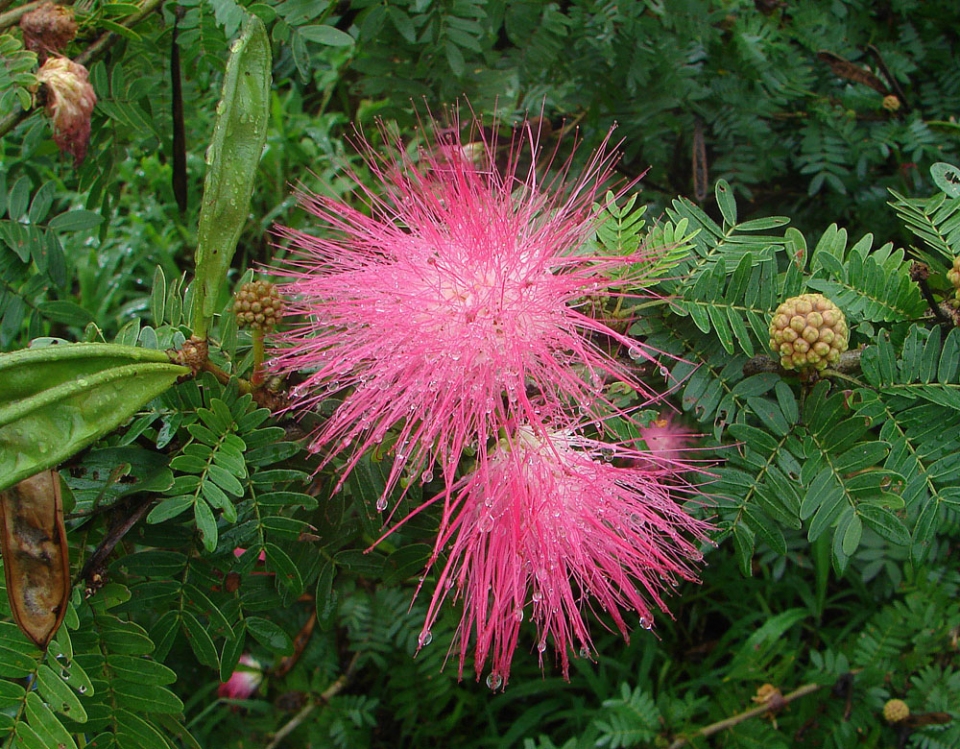Samanea saman

|
|
Samanea saman Common Names: Cow tamarind, French tamarind, Monkey
pod, Rain tree, Arbre de pluie, Saman Scientific
Classification Kingdom: Plantae Clade: Tracheophytes Clade: Angiosperms Clade: Eudicots Clade: Rosids Order: Fabales Family: Fabaceae Subfamily: Caesalpinioideae Clade: Mimosoid clade Genus: Samanea Species: S. saman Synonyms: Albizia saman (Jacq.) F.Muell., Mimosa saman Jacq., Pithecellobium saman (Jacq.) Benth., Inga saman (Jacq.) Willd. Morphological Description Samanea saman is
a large, deciduous tree, typically 15–25 meters tall, with a canopy diameter up
to 30 meters, occasionally reaching 50 meters in width. Its key characteristics
include: · Bark: Rough, wrinkled, greyish-brown, peeling in strips; used
medicinally for its bioactive compounds (Burkill, 1985). · Leaves: Bipinnate, 25–40 cm long, with 6–16 pairs of pinnae, each
bearing 6–16 leaflets (2–4 cm × 1–2 cm); leaflets fold at night or in wet
weather, a nyctinastic trait (Fern, 2024). · Flowers: Pinkish, with white and red stamens, in loose umbelliform
heads (5–7 cm diameter) containing 20–25 tubular flowers; fragrant, attracting
pollinators (Prance & Jongkind, 2015). · Fruit: Broadly linear, compressed, indehiscent pods (10–22 cm ×
1.5–2 cm), black when mature, with sweet, pulpy mesocarp and 5–20 ellipsoid
seeds (Kew Science, n.d.). Distribution and Habitat Samanea saman is
native to Central and South America, widely introduced across tropical regions: · Geographic Range: Native from southern Mexico to northern
Brazil; introduced to Nigeria, Ghana, India, Southeast Asia, Australia, and
Pacific Islands; common in Nigeria’s urban and rural landscapes (Kew Science,
n.d.). · Habitat: Thrives in dry lowland grasslands, moist evergreen
woodlands, and urban settings; adaptable to infertile, waterlogged, or saline
soils (pH 4.5–8.5); prefers full sun and rainfall of 600–3,000 mm annually;
occurs up to 1,500 m elevation (Fern, 2024). · Ecological Role: Nitrogen-fixing legume, enriching soils;
provides shade and forage for livestock; invasive in areas like Fiji,
displacing native vegetation (Burkill, 1985). Ethnopharmacology Samanea saman is
extensively used in West African and Latin American traditional medicine, with
robust ethnopharmacological validation (Vinodhini & Rajeswari, 2018): · Antimicrobial: In Nigeria, leaf and bark decoctions treat infections. · Anti-ulcerogenic: In Nigeria, bark is used for stomach
ailments. Methanolic bark extract (400 mg/kg) reduced ethanol-induced gastric
ulcers in rats by 80%, comparable to standard drugs, by decreasing acid
secretion and increasing gastric pH (Arumugam et al., 2011). · Analgesic: Leaf extracts are used for headaches in Nigeria. Methanolic
leaf extract (100 mg/kg) reduced pain in mice via tail immersion tests, showing
significant latency delay compared to pethidine (Vinodhini & Rajeswari,
2018). · Antioxidant: Fruit pulp is used to combat oxidative stress. Methanolic
pod extracts showed DPPH scavenging (IC50: 141.30 µg/mL), linked to phenolic
compounds like gallic acid (Yusuf et al., 2020). · Laxative: In Nigeria, pod pulp treats constipation. Its sweet, pulpy
mesocarp has mild laxative effects, supported by saponins (Fern, 2024). · Antitubercular: In the West Indies, leaf extracts treat
tuberculosis. Alcoholic leaf extracts inhibited Mycobacterium
tuberculosis in vitro,
validating traditional use (Fern, 2024). · Sedative: In Colombia, fruit decoctions are used as sedatives.
Traditional use suggests CNS depressant effects, though specific studies
on S. saman are limited (Fern,
2024). ⚠ Toxicity Profile: Samanea saman is generally safe at therapeutic doses,
with no widely reported toxic effects. Acute toxicity studies showed no
mortality in mice at methanolic bark extract doses up to 2,000 mg/kg (LD50 >
2,000 mg/kg). High doses (>400 mg/kg) may cause mild gastrointestinal
discomfort due to tannins or saponins. Use is contraindicated in pregnancy and
for children due to insufficient safety data. Potential heavy metal
contamination in wild-harvested plants requires caution (Arumugam et al.,
2011). Additional Uses · Timber: Wood used in Nigeria for furniture, carvings, and
construction; resistant to termites but less durable than teak (Fern, 2024). · Forage: Pods and leaves used as livestock feed in Nigeria, rich in
protein (18–22% in leaves) (Fern, 2024). · Ornamental: Planted in Nigerian cities for shade and aesthetic appeal,
enhancing urban microclimates (Vinodhini & Rajeswari, 2018). · Biogas: Pods explored for biogas production, yielding methane in
rural Nigeria (Vinodhini & Rajeswari, 2018). References
External Links More Pictures |
|
| Compounds of Samanea saman | |
| References |